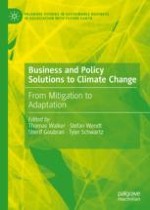2022 | OriginalPaper | Chapter
14. Addressing Climate Change and Waste Management Challenges Through the Development of the Waste-to-Energy Value Chain for Trinidad and Tobago
Author : Don Charles
Published in: Business and Policy Solutions to Climate Change
Publisher: Springer International Publishing
Activate our intelligent search to find suitable subject content or patents.
Select sections of text to find matching patents with Artificial Intelligence. powered by
Select sections of text to find additional relevant content using AI-assisted search. powered by
